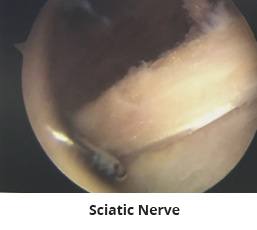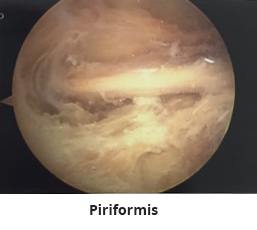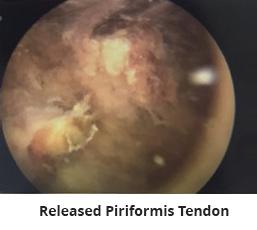Deep Gluteal Syndrome
Pain
There may be a relationship between the hip joint and the buttock region, in terms of pain. Covered on top by the gluteus maximus muscle within the deep gluteal region, the sciatic nerve travels between the ischial tuberosity and the greater trochanter of the thigh bone, and lays near the top of the posterior capsule of the hip ball and socket. The nerve or its branches can be irritated or inflamed in this tissue, causing the literal ‘pain in the butt.’ When the hip is bent, the sciatic nerve migrates somewhat. Under normal patterns of joint movement, the sciatic nerve is flexible enough to stretch and slide to give way with moderate strain or compression. In abnormal conditions, it may be tethered or compressed. This may cause pain.
Trauma, injuries or repetitive motion activities can also be causes for the pain. Referred pain from the tailbone, coccyx, or pelvic floor can also be a contributing factor.
Other Symptoms
- Posterior hip pain
- Inability to tolerate sitting on the affected side
- Pain when stretching the buttock muscles
- Tingling or pins & needles or aching in the buttock or upper thigh
- Tightness in the hamstrings or buttock muscles
Anatomy
The sciatic nerve roots emerge from the lumbar plexus to form a single trunk within the pelvis and exit through the sciatic notch inferior to the piriformis muscle. The sciatic nerve innervates the hamstring muscles. Above the piriformis muscle are the superior gluteal and inferior gluteal nerves. Below the piriformis are the nerve to the quadratus femoris/ gemellus inferior and the nerve to the obturator internus/gemellus superior.
Physical Examination
A few tests that have been suggested to aid in diagnosing sciatic nerve entrapment include passive stretching and active contraction tests.
The Seated Piriformis stretch test
The Pace sign is pain and weakness with resisted abduction and external rotation of the hip.
The Freiberg sign is pain with internal rotation of the extended hip.
A variant of the Freiberg test involves flexion, adduction, and internal rotation of the hip.
The Lasègue sign is pain with straight– leg raise testing (to 90° hip flexion).
Diagnostic Testing
A careful patient history (listening to the patient’s detailed story) and physical examination often yield the best insights. However, some additional diagnostic tests are often necessary. These may include:
- Hip MRI - arthrogram;
- Lumbar (low back) MRI
- Piriformis, SI joint or other injection tests,
- Plain X-rays
- EMG/NCS (nerve conduction studies)
Treatment
At our center in Atlanta, Georgia, our treatment recommendations may be directed at weight loss, muscles strengthening, physical rehabilitation, activity modification, aquatics, stretching and neuromotor balance. This may involve chiropractic care, physical therapy, yoga and so on.
When some or all of the above interventions fail to provide relief for the patient, Dr. Hyman may recommend arthroscopic or endoscopic surgery. This procedure generally involves placing two tiny punctures in the skin, followed by the insertion of high resolution cameras. With these tools, Dr. Hyman has developed the skills and techniques to remove scar tissue or adhesions/bands or tension on the tissues that may be irritating the tendons or nerves in the buttock area. This can be done safely and with good results.


















